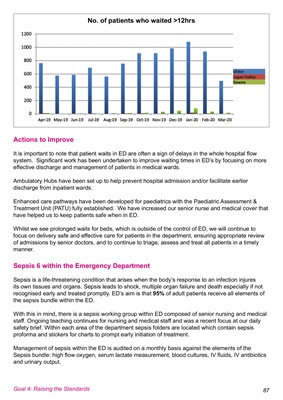
No. of patients who waited >12hrs
Actions to Improve
It is important to note that patient waits in ED are often a sign of delays in the whole hospital flow
system. Significant work has been undertaken to improve waiting times in ED's by focusing on more
effective discharge and management of patients in medical wards.
Ambulatory Hubs have been set up to help prevent hospital admission and/or facilitate earlier
discharge from inpatient wards.
Enhanced care pathways have been developed for paediatrics with the Paediatric Assessment &
Treatment Unit (PATU) fully established. We have increased our senior nurse and medical cover that
have helped us to keep patients safe when in ED.
Whilst we see prolonged waits for beds, which is outside of the control of ED, we will continue to
focus on delivery safe and effective care for patients in the department, ensuring appropriate review
of admissions by senior doctors, and to continue to triage, assess and treat all patients in a timely
manner.
Sepsis 6 within the Emergency Department
Sepsis is a life-threatening condition that arises when the body's response to an infection injures
its own tissues and organs. Sepsis leads to shock, multiple organ failure and death especially if not
recognised early and treated promptly. ED's aim is that 95% of adult patients receive all elements of
the sepsis bundle within the ED.
With this in mind, there is a sepsis working group within ED composed of senior nursing and medical
staff. Ongoing teaching continues for nursing and medical staff and was a recent focus at our daily
safety brief. Within each area of the department sepsis folders are located which contain sepsis
proforma and stickers for charts to prompt early initiation of treatment.
Management of sepsis within the ED is audited on a monthly basis against the elements of the
Sepsis bundle: high flow oxygen, serum lactate measurement, blood cultures, IV fluids, IV antibiotics
and urinary output.
87
Goal 4: Raising the Standards